Lu Peng 2010-03-01
Lu Peng's Home,
Chengdu
Biography:
Lu Peng (b. 1956, Chongqing) is an art historian and curator, and currently lives and works in Chengdu.
Lu graduated from the Political Education Department at Sichuan Normal University in 1982. He then became an editor for the magazine Theatre and Film (Xiju yu dianying), where he worked for three years. In the 1980s, Lu focused his research on Western art history and helped put several publications together, including Correspondences of Cezanne, Van Gogh, Gauguin (1986), Wassily Kandinsky’s The Spirit in Art (1986) and Kenneth Clark’s Landscape into Art (1988).
From 1986 to 1991, Lu was the deputy secretary-general of the Sichuan Dramatists Association and coordinated the oil painting exhibition ‘1988 Southwest Art’ (1988). From 1990 to 1993, Lu became the executive editor of Art and Market (Yishu shichang) magazine. In 1992, he was one of the main organizers of the first Guangzhou Biennial.
Lu has produced a number of books on contemporary Chinese art. In 1992, he published A History of Modern Art in China, 1979–1989 (written with Yi Dan), followed in 2000 by A History of Contemporary Art in China, 1990–1999. Other notable publications are Art Operation (Yishu caozuo) (1994), and more recently, A History of Art in Twentieth-Century China (2009).




















